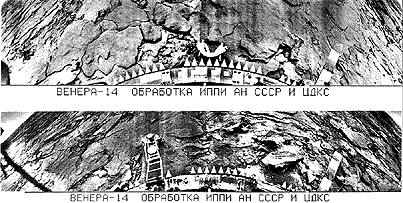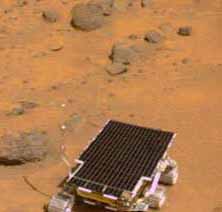|
-------------------------- ------------------- Solar Shocks |
Finally, the deep space explorers--spacecraft which break away from the Earth's gravity. Quite a few were added since this page was posted in 2002. It would be nearly impossible to cover more than a few highlights! Most of the original material is retained here, with some significant additions up to 2016.
Quite a few spacecraft have visited the Moon or orbited around it, e.g. the "Clementine" and "Lunar Prospector". Some lunar explorers--both by the US and the USSR--mapped the moon or landed on it, in preparation for manned landings. The "Luna" series of the USSR conducted 7 soft landing of unmanned probes, two with wheeled "Lunokhod" rovers, and two of those missions returned samples to Earth. The first extraterrestrial rover was the Lunokhod-1 of the Soviet Union, deployed on the Moon in 1970 and exploring it for close to a year. It had a tublike body supported by 8 wheels and a hinged lid lined with solar cells, which opened during the lunar day to soak up sunlight but closed at night to protect the interior. Its mission ended after the open lid accidentally brushed the side of a crater as the vehicle was climbing out, showering the vehicle with moondust. Others spacecraft have visited the major planets of the Solar system. Voyagers 1-2, the "Galileo" orbiter (1989-2003)and "Ulysses" have flown past the giant planet Jupiter: the Voyagers have also visited Saturn (as Pioneer 11 had done), and Voyager 2 continued and visited Uranus and Neptune. The Cassini mission of 1997 visited Saturn and in 2005 sent a probe "Huygens" to land on Saturn's big moon Titan. The Mariner series were early explorers of Venus and Mars--and Mariner 10 even reached Mercury, for three separate encounters! The European pair of Helios spacecraft (A, B) 0f (1974, 1976) ventured inside the Mercury orbit, coming closer to the Sun that any other spacecraft (so far), (031, 0.29 Astronomical Units) : NASA has plans for a "solar probe", to approach within 4 solar radii--only 2% of the Earth's distance, so close that a special shield would be needed to keep it from melting. Incidentally, it would be at that time the fastest moving object in the solar system, moving at 300 km/sec, 10 times faster than the Earth in its orbit.
|

